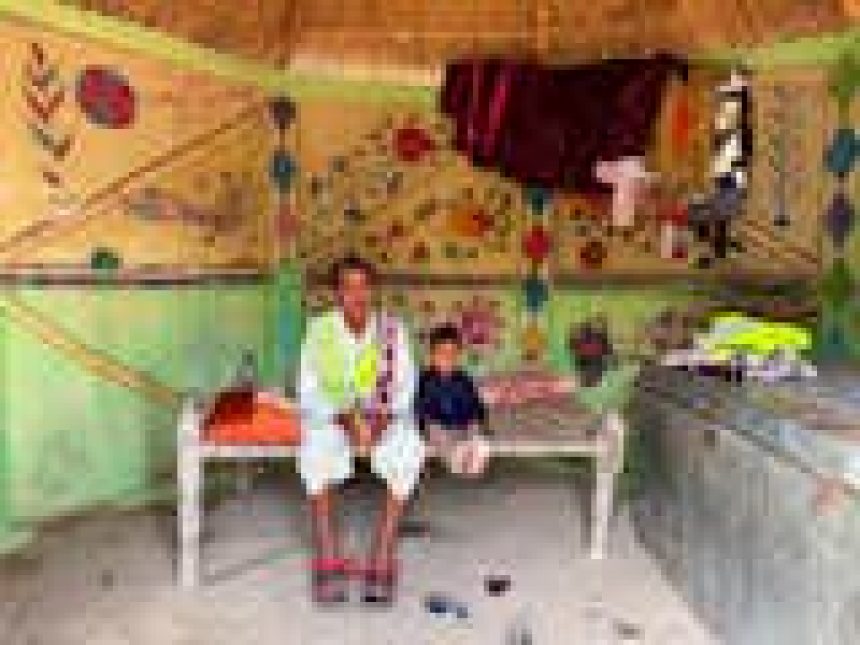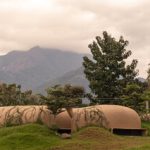Yasmeen Lari reclines on the couch of her home office in Karachi and, after her assistant finagles with a television monitor, flips through a series of slides that propose a path to lift millions out of poverty without spending a penny. The onetime starchitect turned humanitarian and preservation worker announced in 2022 she was seeking funding to build a million bamboo homes for around $100 apiece, after Pakistan suffered its worst-ever floods. This year, she’s shifted her plan, deciding she’d still aim for that, but with a new price tag to outside funders: $0.
“I really believe that everyone wants to have a better life. But they don’t see how they can achieve it,” Lari says. “We put faith in them. We said, ‘Look, you’ve got to do it yourself.’”
Lari, now 83, pivoted in the 2000s from designing hulking concrete landmarks for business magnates and oil companies to building low-cost, zero-carbon relief homes in disaster zones. She began using bamboo after stumbling upon it at a refugee camp in the northwestern Swat Valley and quickly discovered its remarkable resilience to earthquakes and floods. Since the 2022 floods, Lari and the Heritage Foundation of Pakistan, which she founded with her husband to preserve historic structures, have built 50,000 shelters in flood-affected communities. Now, she believes she can replace the need for outside funding by essentially designing a model for communities to do it themselves. If enough people gain the knowledge to build affordable, sustainable housing and infrastructure, while also creating financial opportunities through selling vegetables or terra-cotta tiles, she posits they can make a living teaching others to do the same. She has crafted a plan for villages to first achieve food security, then progress to access to clean water and education, flood-proof bamboo homes, and finally, a fully humming microeconomy.
I first met Lari when she was a guest lecturer at the University of Cambridge in 2023. Last November, I visited her in Karachi, the metropolis she’s called home for most of her professional life, before traveling to Pono, a village in the floodplains of Sindh’s Indus River which her foundation has rehabilitated after the 2022 floods.
Wherever she goes, Lari’s plans are usually met with disbelief; admiration expressed through raised eyebrows and befuddled gazes. As she waited for a meeting at Karachi’s exclusive colonial-era Sind Club, the wife of a pharmaceutical executive approached Lari to express her admiration and asked what she’s working on now. Lari launched into it: food, shelter, education, and clean water for a million households, all with no money raised. The admirer turned to me almost incredulously, as if she had misheard. Lari laughed, gesturing in my direction. “He’s about to see it for himself.”
In the days before I visited Lari’s bamboo villages, she recalled what led her here. The devastation of Pakistan’s floods—$15 billion in economic losses, millions pushed below the poverty line, rapidly spreading waterborne diseases and skin infections, and more than 230,000 children still out of school, according to UNICEF—was most vicious in parts of the country already facing an ongoing social catastrophe. Wealth inequality in Pakistan is extreme, and nowhere more so than in the floodplains of the southeastern Sindh province, where peasant communities live as feudal subjects to powerful landowners whose land they till. Many tell stories of how, when the floods hit, water was diverted from profitable farmland and into the poorest communities. People gathered for weeks on roadsides, the only places that weren’t flooded.
“Suddenly, everything was washed away,” Lari says. “There’s just nothing left, no fields, no greenery, no nothing. These people never had anything much in their lives, but whatever it was, it was all gone.”
The village of Pono lies about four hours outside of Karachi and several galaxies away from the gated, neatly pruned fortress of the Sind Club. Lari, the daughter of a colonial officer, never encountered this world until an earthquake hit Pakistan in 2005, pushing her onto the front lines of relief work. “I had never done it before. I wasn’t trained for it,” she recalls. “I just felt like doing something.”
Lari gradually expanded her humanitarian work throughout the country and especially in Sindh, the backyard of her office in cosmopolitan Karachi. After the 2022 floods, Lari’s success in rebuilding Pono with flood-resistant bamboo homes became her public crown jewel. It was showered with attention by award committees—in 2023, Lari received the prestigious Royal Gold Medal from the Royal Institute of British Architects—and by journalists like me. But it still receives few visitors in the flesh, and in a fortunate coincidence, I arrived alongside a group of builders from Malawi visiting to learn bamboo building techniques, which they want to use in impoverished flood-prone villages back home. Pono, like thousands of villages in the Sindh floodplains, is not connected to the power grid. Still, its residents gathered around a chulah, a low-smoke stove built on a large earthen platform, and welcomed their visitors with song, dance, and traditional music cranked loud enough to pop, drowning out the roar of the generator powering the speaker.
From afar, the enormity of the chulah’s importance is not immediately obvious. Lari’s design is built on a large platform of sun-dried mud bricks and fortified with limestone, keeping food elevated from the ground and free of contamination. When a fire is lit, smoke is emitted through a high chimney, preventing inhalation, and its raised platform also serves as a gathering space during floods.
Lari says the Heritage Foundation of Pakistan has built 800,000 chulahs for families in Pakistan since 2018. “I just wanted them to be safe and have a little dignity,” she explains. But their unexpected benefits quickly revealed themselves. They give people a place to “sit comfortably without any kind of insects and filth around them,” and their large platforms serve as natural communal spaces.
When the first chulah was built in Pono, “a lot of women started gathering there, and it sort of became a community space,” says Ashfaq Ahmed, senior architect at the Heritage Foundation of Pakistan. Quickly, local affairs began revolving around the chulah, from meetings to events and gatherings. “When women are attracted to the chulah, automatically the whole community gets attracted,” he explains, to the point that building the largest, most elaborate chulah has become a stamp of pride. “Everybody tries to build as big of a platform as possible because everybody wants to show off.”
Lari has always spoken pointedly about ensuring that women can be decision-makers in their communities, and the chulah is essentially an engineered form of giving them power to oversee projects and manage collective funds. Other villages began to realize its importance as both a flood relief space and a community center, creating a demand for chulahs that is “self-propelling, it goes by itself,” Lari says.
“If there’s no chulah, there’s no platform, there’s no common space,” says Naheemalso utilized Shah, project manager for the Heritage Foundation of Pakistan, who works in the field constantly and has witnessed people prioritize building communal areas before focusing on their own homes. Heritage workers quickly noticed an eagerness within communities to provide for children and to help each other. When the foundation began designing schools, Lari believed communities would collect money to build them first, even before their own homes. But at first, even her own staff wasn’t convinced.
“We never thought they would be more interested in building schools because they don’t have toilets. They may not have chulahs. Some people may not have a proper home,” Ahmed says. “Even we were shocked.”
The schoolhouses are slightly larger versions of the bamboo homes themselves, constructed with bamboo frames covered with lime plaster. Lari’s eight-sided bamboo shelters can famously be built for less than $100 apiece, relying on prefabricated frames with diagonal reinforcements that also provide resistance to earthquakes, a method also utilized in other countries such as Ecuador. These panels can also be moved and reused if floods destroy the exterior plastering and the roof, made of thatched leaves bound tightly to prevent water intrusion while also allowing hot air to escape. They’re an evolution and improvement of a common Sindhi structure—their conical roofs can also reduce the effect of Pakistan’s deadly summer heatwaves, which this year reached 120 degrees Fahrenheit. “It’s a tradition of vernacular architecture,” Ahmed says.
During our visit, the Malawian group was immediately impressed and began brainstorming how to adapt the structures to their own communities. “The secrets we have learned [of] bamboo are marvelous,” says Muhammad Yusufu, who was visiting Pakistan for the first time as part of a trip organized by Spiritual Chords, a South Africa-based nonprofit whose founder is a longtime friend of Lari’s. Yusufu already foresaw constructing bamboo homes in the southern floodplains of Nsanje, where people withstand yearly floods as they are reliant on the fertile farmland. “They build with bricks. Once it’s affected by water, it gets dissolved,” he says.
So far, about 50,000 have been built since 2022—a far cry from a million, but impressive considering they have been constructed almost entirely without donations. To get to a million without outside money, the Heritage Foundation trains people to build homes, chulahs, toilets, and other essential structures in their own villages, along with skills like thatching roofs and crafting terra-cotta tiles. Then, people who learn the skills can join “barefoot brigades,” which travel and teach other communities. As they earn more money, they eventually buy motorcycles and travel even further.
These residents are people like Rano, who joined a brigade after his own village of Kewal Kohli was flooded after heavy rainfall in 2023. When he migrated to higher ground, he passed by Pono, which remained unscathed. “We saw that it was completely safe,” he recalls. “The villagers were happy.” Residents of Pono invited him to take shelter, and he learned about the flood-resistant structures. Rano used to make about $1.60 each day growing crops for a local landlord. He now makes around triple that amount, he says, by providing multiple lessons each day to villages that collectively pay about $1 each to learn skills like building chulahs and making fuel briquettes—a small enough sum for a poor village to save once they see their neighbors benefit from the innovations.
It’s an entire microeconomy: Villages are saving what they earn, receiving no donations, and locally sourcing almost everything. People take pride in the elaborate, colorful designs of their chulahs and homes; when I visited, women were decorating using lime plaster and paint made from rocks. It’s easy to notice the wondrous quality of their designs, the first step into a world of possibility. “They’re creating a dreamworld,” Lari says.
It was all visible from the panoramic balcony of a two-story community center, where the Malawian builders were attending a lecture on bamboo construction techniques. Inside, walls were painted with blue and orange flowers, and colorful facades below glistened with peacocks and bright, beaded patterns. Adjacent to the central chulah is a series of bamboo homes built specifically for visitors equipped with private bathrooms, light and power fixtures, and seated compost toilets, along with a large, sweeping bamboo pavilion, where they eat under the shade.
Just beyond a nearby road, I could see the rest of Pono, the area still untouched by the interventions of Heritage builders and what feels like a world away, a clear sign of the region’s crushing poverty, and, after sleeping in its guesthouses, a distinction stark enough to provoke discomfort. As I walked through the village, I saw signs of slow but visible progress. Some existing homes had been reinforced with bamboo around door frames, and a few chulahs and community toilets had been constructed, but its relative hardship made the other side of Pono feel like a showpiece. Residents here are still in the stages of earning money to build, Shah says; they’re about eight or so months away from affording to build the same homes their neighbors enjoy.
Lari has devised a multistage pathway through which villages progress, starting with food security and moving on to securing a clean water supply, building flood-proof homes for every family, and developing a sustainable source of income. This side of Pono has reached the first rung of the ladder.
The nearby village of Altaf Khaskheli, almost entirely untouched by Heritage intervention, has not reached this step. A few chulahs have been built, but most people still cook on ground-level pit stoves. Outhouses are crudely fenced areas that often don’t have a hole in the ground. The mud walls of homes are deteriorating, and roofs thatched from tree branches block the sun but don’t keep rain out. “These are not safe structures,” Shah says.
Lari wants to build faster. Still, she believes asking for monetary donations will destroy the essence of her project, turning people into beggars. I ask her how flexible she’s willing to be about asking for cash donations, and witness the same single-minded stubbornness that Shah and Ahmed encountered when Lari insisted that communities would prioritize schools over homes. To her, modern charity is wedded to a colonial model of subservience that does more harm than good, even as each passing year brings a greater threat of extreme heat and catastrophic flooding, of homelessness and disease, of lost lessons and stunted growth, of social calamity.
Some research—it’s mixed—suggests that cash injections can work. But Lari is convinced: She thinks cash would hurt communities. She accepts in-kind donations, such as television monitors for schools, but still prefers that people raise money to buy them instead. Lari concedes she could tolerate monetary aid “as long as it’ll go to my woman’s committee bank accounts,” which control village finances. “But it’s got to be done in the right manner.” Many donations in Pakistan are allegedly pilfered by corrupt officials before making their way to people in need. I wonder if the architect in Lari sees outside charity as incompatible with her design—a compromise that dampens her late-career magnum opus—while the human in Lari has been scarred by donors who work against the interests of the communities they serve.
Gharad Bryan, a professor studying cash transfer programs at the London School of Economics, argued in 2019 that the developed world overlooks the “surplus labor” in impoverished countries—that providing aid can unlock the potential of people who otherwise have little to do. Lari agrees enthusiastically with his findings. “People have tremendous potential, and also poverty has tremendous potential,” she says. “That’s why money is important, but not that important. A little bit of funding will help them. But even if they don’t [receive aid], it just means [building] takes longer.”
“I need one more year to be able to do more,” she adds. “Come back next year and see the difference.”














